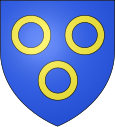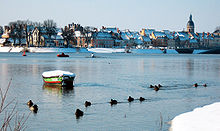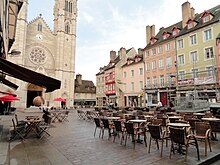Chalon-sur-Saône
| Chalon-sur-Saône | ||
|---|---|---|

|
|
|
| region | Bourgogne-Franche-Comté | |
| Department | Saône-et-Loire | |
| Arrondissement | Chalon-sur-Saône ( sub-prefecture ) | |
| Canton |
Chef-lieu of Chalon-sur-Saône-1 Chalon-sur-Saône-2 Chalon-sur-Saône-3 |
|
| Community association | Le Grand Chalon | |
| Coordinates | 46 ° 48 ' N , 4 ° 51' E | |
| height | 172-192 m | |
| surface | 15.22 km 2 | |
| Residents | 45,096 (January 1, 2017) | |
| Population density | 2,963 inhabitants / km 2 | |
| Post Code | 71100 | |
| INSEE code | 71076 | |
| Website | www.chalon.fr | |
Chalon-sur-Saône [ ʃa.lɔ̃.syʁ.soːn ] is a French city .
geography
Chalon-sur-Saône is located in the department of Saone-et-Loire in the region of Bourgogne Franche-Comté . With 45,096 inhabitants (as of January 1, 2017) it is the largest city in the département, but not its administrative seat, but only the seat of a sub-prefecture. Chalon is the second largest city in Burgundy after Dijon .
The city lies on the banks of the Saone , at the end of the Canal du Center and has a river port. It is the market for western Bresse , for grain and regional wines . Chalon-sur-Saône station is on the Paris – Marseille line .
history
Antiquity
Chalon-sur-Saône was called Cabillonum in antiquity , it was one of the main places in the Äduer in Gallia Lugdunensis and is first mentioned by Caesar ( De bello Gallico 7, 42 and 7, 90). This put a garrison in the city, which 52 BC. At first it was under the command of the military tribune Marcus Aristius , whom the inhabitants drove out, then under the command of Quintus Tullius Cicero , the brother of the famous speaker . A Roman naval prefect later had his seat here, as the emperors maintained a flotilla on the Saône. The place on Via Agrippa also had grain stores for the army and brisk trade. The holy Marcellus intended here that Christianity have spread and 178 n. Chr. The martyr have died. Chalon was the seat of a bishop from the 4th or 5th century . The place was destroyed in 406 by the Vandals and 451 by the Huns of Attila .
middle Ages
In 471 Chalon became Burgundian and in 534 Franconian . Around 555, Chram , the rebellious son of Chlothar I , devastated Chalon, which King Guntram I later made the residence of the Kingdom of Burgundy and thus one of the most important and attractive cities in Gaul and subsequently the site of important synods . In 732 the city was devastated by the Saracens and in 761 by Duke Waifar of Aquitaine and besieged in 834 by Emperor Lothar . In the division among the sons of Louis the Pious , it came to Charles the Bald .
In the 10th century Chalon and its territory formed the Burgundian feudal county of Châlonnais . Half of this was bought in 1097 by the Bishop of Châlon . The other half had been inherited by the Count of Donzy and came to the Duchy of Burgundy in 1237 in exchange for the rule of Salin and in 1477 with Burgundy to the French crown domain , the Domaine royal .
In 1256, Duke Hugo IV of Burgundy, who had acquired the county of Châlonnais in 1237, granted the town of Chalon municipal rights. Philip the Bold had it fortified again in 1368. Because its inhabitants had sided with his daughter Maria after the death of Charles the Bold (1477) , they were taken over by Georges II de La Trémoille , Lord of Craon, on behalf of King Louis XI. besieged and had to surrender after long resistance, whereupon the most respected citizens were thrown hand and foot shackled into the Saône. Franz I had the fortifications repaired, including the suburbs.
Early modern age
In 1562 the Huguenots under Montbrun conquered the city, but were defeated by Tavannes . In 1563 the citadel was built with five bastions. The Catholic League took possession of the city in 1589 under the command of Mayenne , to which the Marshal of Aumont came with his troops in 1591 . The unrest lasted until 1595.
After the French Revolution , the Diocese of Chalon was dissolved in 1801 and its territory was incorporated into the Diocese of Autun .
Modern times
Chalon is known as the birthplace of photography ( heliography ). The city's most famous citizen is Joseph Nicéphore Nièpce , whose invention there is a museum on the Quai des Messageries that contains more than 2 million photographs and many artifacts, cameras and other pieces of equipment from the entire history of photography.
On October 6, 1943, a serious railway accident occurred near Chalon-sur-Saône when a freight train derailed and an express train following it drove to Lyon . 21 people died, 90 were also injured.
Attractions
The St. Vincent Cathedral on Place Saint-Vincent, the main part of which dates from the 12th to 15th centuries, has - in addition to the neoclassical facade from the 19th century - architectural elements that date back to the 8th century. The old town around the cathedral is partially well preserved. Opposite the church of St. Pierre from the 18th and 19th centuries is the Musée Vivant-Denon , in which, in addition to a collection of paintings, Roman and Merovingin finds are on display. The Tour du Doyenné from the 15th century and the Hôpital founded in the 16th century, including a chapel with its original glass windows and a pharmacy, are located on an island in the Saône .
Culture
Theater festival
In France, Chalon-sur-Saône is known for its theater festival Chalon dans la rue . This street festival has been held every year in mid-July since 1986 throughout the historic city center. Street artists from France and now many other countries perform in squares, courtyards and on the street. The festival is divided into performances from the off and in areas. The off events can be attended without admission, while the in performances cost admission.
Personalities
sons and daughters of the town
- Caesarius of Arles (470-542), Archbishop of Arles
- Hugo Donellus (1527–1591), lawyer
- Joseph Touchemoulin (1727–1801), violinist and conductor in Bonn and Regensburg (Princes of Thurn and Taxis )
- Vivant Denon (1747–1825), concerned with converting the Louvre into a museum after the French Revolution . One of the wings of the Louvre, the Palais Denon , is named after him.
- Claude-Madeleine Grivaud de La Vincelle (1762–1819), archaeologist
- Joseph Nicéphore Nièpce (1765–1833), one of the inventors of photography
- Charles Méray (1835–1911), mathematician
- Jean Champion (1914–2001), actor
- Jeannette Guyot (1919–2016), resistance fighter in World War II
- Roger Grosjean (1920–1975), archaeologist
- Gérard Collomb (* 1947), politician (PS, En marche!), Mayor of Lyon and Minister of the Interior in the government of Édouard Philippe
- Jean-Loup Puget (* 1947), astrophysicist
- Rachida Dati (* 1965), politician (UMP), Minister of Justice in the government of François Fillon, grew up in Chalon-sur-Saône
- Steeve Guénot (* 1985), wrestler
Town twinning
See also
Web links
- Maximilian Ihm : Cabillonum . In: Paulys Realencyclopadie der classischen Antiquity Science (RE). Volume III, 1, Stuttgart 1897, column 1163.
- Official website
Individual evidence
- ↑ French Statistics Institute ( www.insee.fr )
- ^ Peter WB Semmens: Catastrophes on rails. A worldwide documentation. Transpress, Stuttgart 1996, ISBN 3-344-71030-3 , p. 109.
- ↑ Official website Chalon dans la rue
- ↑ Picture gallery Chalon dans la rue 2012 ( Memento of the original from December 22nd, 2015 in the Internet Archive ) Info: The archive link was inserted automatically and has not yet been checked. Please check the original and archive link according to the instructions and then remove this notice.







